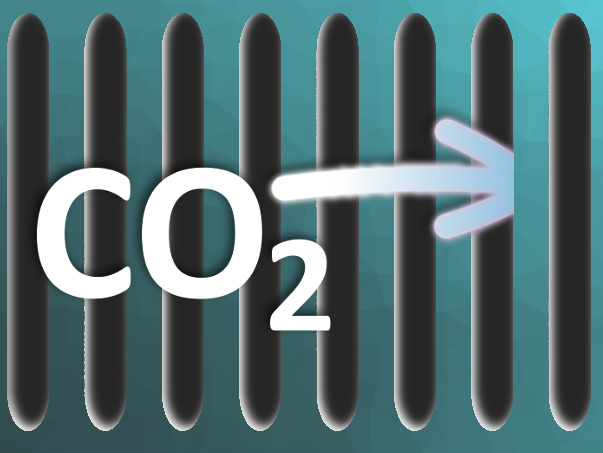Carbon dioxide can be separated from gas streams by chemisorption, but the regeneration of the scrubbing liquids used for these processes is expensive. Physical methods for trapping CO2 in microporous materials are not much better, since they lack selectivity. Josef Breu, University of Bayreuth, Germany, and colleagues have designed a material with slit-shaped micropores—a synthetic hybrid clay mineral—that efficiently captures CO2 from gas streams. Moreover, it is robust, simple, cheap, and regenerable.
From Carbon Scrubbing to Carbon Capture
The dominant carbon capture technology is carbon scrubbing, the chemisorption of CO2 in alkanolamine solutions. Its main problem is the energy-intensive regeneration of the formed carbamate product. To find alternatives, researchers have been investigating microporous solid materials for physical adsorption. Physisorption has the advantage that the regeneration of the sorbent is easy, but the downside is that it is less selective.
To improve selectivity, the team investigated a pillared ultramicroporous material called “microporous organically pillared layered silicate 7”, or MOPS-7. This material has slit-shaped pores that only allow very small molecules to enter. The pore walls attract and bind carbon dioxide through electronic interactions.
MOPS: Organically Pillared Synthetic Clay
The researchers constructed the MOPS from a synthetic clay mineral, fluorohectorite, which allows cation exchange. The team exchanged the sodium ions residing between the silicate layers with 1,4-diaminobutane (DAB) by simply stirring a suspension of fluorohectorite platelets in water with DAB hydrochloride.
By intercalating in the silicate sheets, the DAB molecules form a dense two-dimensional array of pillars, but not like upright columns carrying a ceiling. Instead, the DAB molecules lay flat on the silicate surfaces, forming a maze of walls with rectangular passages between them.
This means that the height of the pores is the interlayer spacing (defined by the diameter of the DAB molecules), but their widths are the passage widths, spanning at least the distance between the protonated amino groups. This architecture gives the pores a slit shape. The team anticipated that only CO2 with its small kinetic diameter of 0.33 nm would be able to enter the narrow slits, and methane and nitrogen would be too large. This feature would make MOPS-7 a molecular sieve, holding back CO2 molecules but allowing larger gas molecules to pass through.
Sieving CO2 Molecules from Gas Mixtures
The researchers tested three model gas mixtures for their behavior on a column containing MOPS-7: a model flue gas with a CO2 to N2 ratio of 15:85, a model biogas with a 50:50 ratio of CO2 to methane, and a model natural gas with 5 % CO2 and 95 % methane. In all cases, CO2 was eluted last, as the other gases did not adsorb at the column.
All three of these gas mixtures need to be freed of carbon dioxide for real applications. Capturing CO2 from flue gas is one strategy in striving for a carbon-neutral society. In biogas, a high CO2 content diminishes its suitability as a fuel. The separation of residual CO2 from natural gas, a process called sweetening, is necessary to avoid pipe corrosion.
Selective, Efficient, Robust, Simple, and Cheap
According to the researchers, the MOPS-7 material is selective and efficient, separating CO2 from the gas mixtures at various partial pressures and under ambient conditions. Flushing with helium removes the adsorbed CO2, and the material can be regenerated many times without loss of performance. It also withstands a large temperature range.
The performance of the MOPS can compete with other physisorbents currently being investigated for CO2 capture, while being significantly cheaper. The team estimates a price of about USD 40 per kg for the raw materials (the clay and DAB), which they say is about one tenth of the prices of comparable physisorbents. The researchers also highlights that the size and chemistry of the pores can be readily adjusted. For example, they plan to make the pore walls more hydrophobic to achieve more favorable adsorption enthalpies, and thus, better selectivity.
The team had not intended to make a physisorbent with the largest surface to volume ratio or the highest capacity to hold CO2. Instead, they focused on finding a simple material that works efficiently under industrial requirements. However, the MOPS has yet to pass a final test: How will it perform with humid gas streams? Selectivity against water vapor is a critical issue of many known physisorbents. If the MOPS fails here, the researchers are optimistic that this issue can be solved by chemical tuning.
- Diammonium-Pillared MOPS with Dynamic CO2 Selectivity,
Martin Rieß, Renée Siegel, Jürgen Senker, Josef Breu,
Cell Rep. Phys. Sci. 2020, 1, 100210.
https://doi.org/10.1016/j.xcrp.2020.100210




